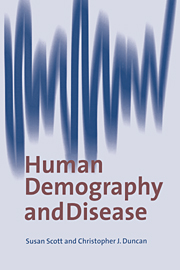Book contents
- Frontmatter
- Contents
- Preface
- Conversion table for imperial to metric units
- 1 Introduction
- 2 Tools for demography and epidemiology
- 3 Identification of population oscillations: a case study
- 4 Density-dependent control and feedback
- 5 Modelling the endogenous oscillations and predictions from timeseries analysis
- 6 Cycles in the grain price series
- 7 Interactions of exogenous cycles: a case study
- 8 Mortality crises and the effects of the price of wool
- 9 Modelling epidemics for the demographer: the dynamics of smallpox in London
- 10 Non-linear modelling of the 2-yearly epidemics of smallpox: the genesis of chaos?
- 11 Measles and whooping cough in London
- 12 Integration of the dynamics of infectious diseases with the demography of London
- 13 Smallpox in rural towns in England in the 17th and 18th centuries
- 14 Infectious diseases in England and Wales in the 19th century
- 15 Prospectives – towards a metapopulation study
- References
- Index
11 - Measles and whooping cough in London
Published online by Cambridge University Press: 25 January 2010
- Frontmatter
- Contents
- Preface
- Conversion table for imperial to metric units
- 1 Introduction
- 2 Tools for demography and epidemiology
- 3 Identification of population oscillations: a case study
- 4 Density-dependent control and feedback
- 5 Modelling the endogenous oscillations and predictions from timeseries analysis
- 6 Cycles in the grain price series
- 7 Interactions of exogenous cycles: a case study
- 8 Mortality crises and the effects of the price of wool
- 9 Modelling epidemics for the demographer: the dynamics of smallpox in London
- 10 Non-linear modelling of the 2-yearly epidemics of smallpox: the genesis of chaos?
- 11 Measles and whooping cough in London
- 12 Integration of the dynamics of infectious diseases with the demography of London
- 13 Smallpox in rural towns in England in the 17th and 18th centuries
- 14 Infectious diseases in England and Wales in the 19th century
- 15 Prospectives – towards a metapopulation study
- References
- Index
Summary
In addition to smallpox, measles and whooping cough were also serious lethal diseases in earlier centuries in the UK. Although these are now conquered in the developed world they remain a serious threat to life in Third World countries where, it has been estimated, 17 million people die annually from infectious diseases. Conditions there, with poor nutrition and inadequate medical services approximate to life in England in the 17th and 18th centuries, where fatality rates fell only towards the end of the 19th century. Thus, in many underdeveloped countries today, malnutrition and infectious diseases can occur in the same unfortunate children and together they play a major role in causing high child mortality and morbidity rates (James, 1972; Glasziou & Mackerras, 1993). In particular, measles remains as a significant threat to life in those regions of Africa and Asia where nutrition is inadequate (Fraser & Martin, 1978).
The dynamics of measles and whooping cough in London are studied by time-series analysis in this chapter and the possible effects of seasonal driving and malnutrition are correlated with the mathematical modelling presented in section 9.3.
Measles epidemics in London, 1630–1837
Bolker & Grenfell (1992) wrote of measles epidemics:
Most humans who have lived since the time of Babylon have caught the measles virus. Measles is so infectious that in small isolated human populations the infection burns itself out … measles has probably evolved since the first densely settled human civilization (Bartlett, 1957; Black, 1966). Improved communications now mean that few communities are isolated, and almost everyone in the world is exposed to measles. […]
- Type
- Chapter
- Information
- Human Demography and Disease , pp. 222 - 243Publisher: Cambridge University PressPrint publication year: 1998



